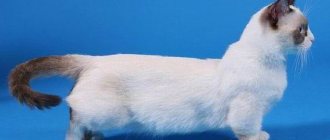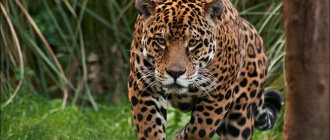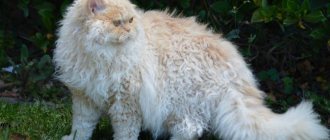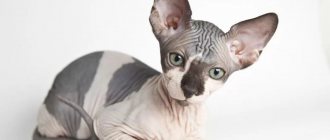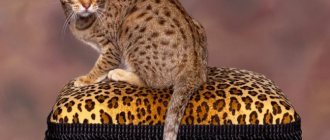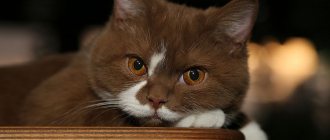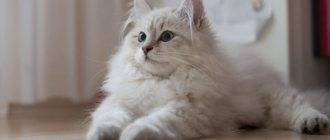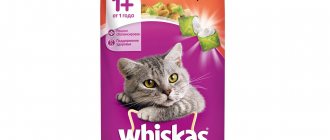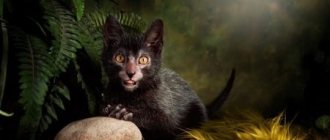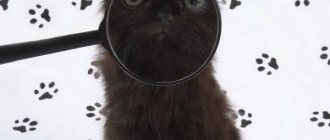Dwarf cat breeds
If miniature dogs have been popular since ancient times, the fashion for dwarf cats has appeared quite recently. And it all started with munchkins. Fans of the original cats liked their incomparable paws so much that breeders soon showed the world a whole “bouquet” of new short-legged breeds, in the creation of which the munchkin was somehow involved. For example, in alliance with the Persian he became Napoleon, with the Sphinx - bambino, with Curl - Kinkaloo, and so on.
Felinologists have an ambiguous attitude towards experiments on breeds that carry genetic mutations. And, for example, in Germany, crossing sphinxes with munchkins is strictly prohibited. Mindless pursuit of the hilarious appearance of cats can cause serious harm to these animals. But the demand for exotics is growing, and along with it the number of cat and dog “minis” is growing. The less, the more expensive.
Baby cats have big loving hearts
Since many of the miniks have short legs, the main criterion for assessing breed size is the weight of the animal, and not its height or body length. The undoubted leadership in the “construction” of designer breeds belongs to American breeders.
Bambino
The Italian word "bambino" translates to "baby". The creators of the breed conceived the bambino as an eternal child - a cat that will remain a kitten until old age and, with its touching appearance, will encourage a person to care and other good feelings. As already mentioned, this “child” came from purposeful matings of munchkins with Canadian Sphynxes. The name of the breed was suggested by one of the initiators of its creation, an Italian breeder.
Bambino is always ready to play
The largest cat of this breed weighs up to four kilograms. Watching the bambino, you understand: the game is the main meaning of his life. These cats are sociable and friendly, they enthusiastically respond to any offer to play - no matter who it comes from: an adult or a child, from another cat or even a dog.
Bambino kittens cost from six hundred dollars - a very modest price for such exotic animals. The popularity and demand for this dwarf breed are growing, and accordingly, more and more offers for the sale of kittens are appearing in nurseries.
Video: bambino - “suede” cats with short legs
Napoleon
The Emperor of France, after whom this cat was named, had a proud, albeit cocky disposition, and was also short in stature. This is the image that American breeder Joe Smith imagined when he conceived a new breed, the ancestors of which he chose royal Persians and baby munchkins.
Alas, the name of Napoleon's cat is just a joke, and the great Bonaparte would never have dared to pet this charming creature. After all, as you know, the French emperor suffered from ailurophobia - the fear of cats. By the way, in 2015 the breed received a new name - Minuet.
The name of the Napoleon cat is nothing more than a joke by the creator of the breed
Napoleon weighs no more than two kilograms. Having inherited a round muzzle and large expressive eyes from the Persians, the short-legged descendants “refused” the flattened Persian nose - Napoleons have a proud, almost Roman profile, and therefore they never snore, snore or have other problems in this regard.
These are generally almost problem-free cats with an ideal character, much better than that of their crowned namesake. Even caring for Napoleon’s luxurious fur is not difficult - it combs well and does not fall into felt, like the Persians.
The average cost of a small purebred Napoleon is about nine hundred dollars. Individuals with beautiful long hair of spectacular solid colors are especially highly valued:
Video: Napoleon - hassle-free cutie
Lamkin
This very rare breed is bred only in a few breeding nurseries in New Zealand and the USA. “Lemkin” is translated into Russian as “lamb” - the cat received this name for its soft curly fur and gentle, easy-going character. Lamkins (or lambkins) are the fruits of love between Munchkins and Silkirk Rex. That's why they are sometimes called nanus rex.
Lamkin really looks like a tiny curly lamb
In adulthood, the lambkin's weight can range from one and a half to four kilograms. Such a wide range of body weight and other significant differences in the appearance of the animals are explained by the fact that the breed is still too young and unstable. No one can say exactly how many Lambkins are alive in the world today—perhaps only a little over a hundred.
You rarely see Lamkin at exhibitions - firstly, there are offensively few of them, and secondly, the breed has the status of experimental according to TICA. And registration of a breed with TICA as experimental does not mean its recognition. But this does not prevent the Lamkin from remaining one of the most expensive cats in the world - fans of the breed sign up for kittens long before they are born, and the cost of such a curly baby starts from three thousand dollars.
Video: few people have seen the Lamkin - but it exists!
Munchkin
Munchkins are called whatever they call them: dachshund cats - for their short legs and long body, magpie cats - for their thieving passion for small things, kangaroo cats - for their ability to sit in a “column” for a long time... In fact, the breed got its name from the small fantastic folk invented by writer Lyman Frank Baum.
The history of the breed is quite interesting. In 1983, a strange short-legged cat was picked up and sheltered by a kind American woman. To the surprise of the owner, the cat, which she named Brambleclaw, after some time gave birth to kittens - the same short-legged ones as herself. All modern munchkins trace their ancestry from this cute family.
A true gentleman, the munchkin is the ancestor of the short-legged cat “folk”
The average weight of a munchkin is three kilograms, but there are individuals that weigh more - up to five kilograms. So this is far from the smallest of the dwarf cat breeds. Munchkins are all about virtues: they are smart, extremely charming, friendly, cheerful and easy-going. The curiosity of this cat literally knows no bounds and... obstacles - he examines all the corners, cabinets and shelves in the house, certainly hiding a few things he likes as “mementoes”.
"Magpie Cat" - a lover of rummaging through boxes
What else makes munchkins happy is their good health. Litters usually contain both short-legged and “normal-legged” kittens. If the first ones cost about a thousand dollars, then the second ones can be bought three or even four times cheaper. At the same time, they will be real munchkins - in everything except the length of their paws - with a pedigree and the right to participate in breeding.
Video: all about these amazing munchkins
Skookum
Skookum is an exotic and somewhat unexpected name for a cute curly-haired cat, because translated from one of the Indian languages the word means “strong, huge, mighty, unbending.” Like most dwarf breeds, the Skookum is also a descendant of the Munchkin, and its second ancestor was the Laperm.
Skookum cat, “huge and powerful”
The weight of skookums can range from one and a half to four kilograms. They may seem larger than their actual size due to the cloud of wonderful curls that they proudly carry. You can really be proud and admire such incomparable wool - of course, if the owners pay enough attention to caring for it. A pet-level Skookum can cost from six hundred dollars, and the price of a show animal is several times more.
Video: Skookum - a curly hair with a golden character
Singapore
The Singaporean cat is almost the only dwarf breed that comes not from America, but from Asia and has a fairly long history. The name “Singapura” clearly speaks of its country of origin: it was in Singapore that very special “mongrel” cats lived for a long time, and one of the most elite breeds in the world traced its pedigree to them.
Like most native breeds, the Singapura boasts a strong immune system and a stable nervous system, which largely determines the health of the cat.
Singapura - “alien” from the cat family
Singapura cats weigh up to two kilograms, and the largest cats weigh up to three. They are distinguished by the unique quality of their coat, ticked color and incredible, “alien” eyes with a piercing gaze. Surprisingly, these babies mature very late - only by the age of two.
The cost of Singapore kittens ranges from three hundred to almost two thousand dollars - depending on the breed qualities and the availability of a package of documents
Video: Singapura - a small cat with huge eyes
Kinkaloe
The Kinkalow (or Cankalow) cat managed to combine all the best from its parent breeds - the funny appearance of the Munchkin, and from the American Curl - not only exclusively curled ears, but also much more important qualities: a wonderful character and good health. These cats of American selection are famous for their high intelligence, which is especially valuable in combination with their childlike spontaneity.
Owners are touched by the ability of the Kinkolou to freeze for a long time in the meerkat pose - sitting in a column on its hind legs, leaning on its tail. Until recently, only inquisitive munchkins were able to demonstrate such an exclusive “fit.” For a short-legged baby cat, such a skill can dramatically improve visibility of the surrounding area.
Kinkaloos can “sit upright” like their Munchkin ancestors.
The maximum weight of an adult Kinkalow cat is three kilograms. The breed is very difficult to breed, since the genetics of the Kinkalow are still unstable and unpredictable - in each litter there can be kittens with the appearance and heredity of either a Munchkin or a Curl. All babies are born with normal ears, and only from the age of one and a half weeks do they suddenly begin to curl back in some kittens.
The felinological organization TICA recognized the Kinkaloo back in 1997 - but only as an experimental combined breed. Kinkalow is difficult to translate literally from English: kink means curl (meaning the shape of the ear), and low means low (this is about height).
There are only a few dozen “pure” kinkalows in the world. Such kittens cannot cost less than a thousand dollars, or even many times more - if they are delivered from overseas nurseries. However, non-standard kittens, which are the majority of litters, can be bought much cheaper - for two hundred to three hundred dollars - and they will have a Kinkalow pedigree, although these babies can look like anyone.
Video: kinkalow - short legs, curled ears
Minskin
The young dwarf breed, originally from the American state of Massachusetts, was obtained by successively crossing four breeds: the Canadian Sphynx, the Munchkin, the Devon Rex and the Burmese. An inquisitive and sociable fidget Minskin adores his owner and does not tolerate loneliness.
These amazing cats look like monkeys. The Minskin has hind legs higher than the front legs and a very long tail. He also has a very expressive face with huge eyes and ears. The creation of a new breed began in 1998 with... a drawing - the “author” of the Minskins, a young American, Paul McSorley, came up with a strange cat and sketched his portrait on paper. The cat, which no one had yet seen, was molded to fit this image - and now it fully matches its portrait.
Minskin - an eternal kitten that looks like a monkey
Representatives of the breed do not grow heavier than three kilograms. Interestingly, they are not completely devoid of hair - here and there along the folded body there are islands of fur, short, soft and very pleasant to the touch. This is how they differ from the completely hairless Bambino breed, of which Minskins are considered a variety. But four breeds were used to create Minskins, and two breeds were used to create Bambinos.
Minskins differ for the better from many other designer cat breeds in that they do not have serious health problems. Their proper breeding is monitored by the international felinological association TICA, which not only officially recognized the experiment with Minskins as a success, but also proposed a separate program to control the development of this unusual breed.
By American standards, the price of a Minskin kitten is not too high, as for a designer breed - a pet-class baby on average can cost about six hundred dollars. But if you intend to buy this miracle from a US nursery, add transportation costs to the cost - the amount will increase significantly.
Video: Minskin - a gnome cat with big ears
Dwelf
Charming bald heads with curled ears are the product of the most complex selection of American felinologists. The mini-breed was bred on the basis of the Canadian Sphynx, to which the blood of the American Curl and Munchkin were infused. The result is three mutations in one Dwelf: hairlessness, short legs and “ears with horns”.
The breed is very rare and young. Getting a full-fledged Dwelf is very difficult, because in one litter these cats can have the most diverse and sometimes incredible combinations of qualities of their ancestors - from long-legged munchkins to shaggy sphinxes. Usually only one kitten, or at most two, fully meets the standard of a new breed.
Dwelf - an angel with the appearance of an imp
The weight of an adult animal of this breed rarely exceeds two kilograms, and breeders strive to further reduce the size of the Dwelf. However, experimenting in this direction must be done with great caution, since breeding cat minis is already extremely difficult. With proper selection of the parent pair, a triple breed mutation does not negatively affect either the health or the genetics of the offspring.
The exclusivity of this unusual breed also dictates its very high price - the cost of a kitten that meets the standard starts at two thousand dollars.
Video: Dwelf - three mutations in one cat
Skif-tay-don is the smallest breed
Skif-tay-don (or skiff-toy-bob) takes first place in the ranking of dwarf cats. This very unusual breed is the pride of Russian felinology, as it was bred in Rostov-on-Don. The first officially registered kittens were born in 1987.
Rostov breeder Lyudmila Krasnichenko bred and has been supervising the breed of the smallest cats all this time. The ancestor of the breed was a kitten named Kutsy, born from Thai parents, but strikingly different from his littermates in his small size and short tail.
Skif-tay-don is a subject of special pride for Russian breeders
Skif-tay-don does not grow larger than a five-month kitten of ordinary breeds and weighs an average of two kilograms. Toy bean crumbs are very beautiful and harmonious, which is always noted by experts at exhibitions.
Despite the domestic origin of this supermini, its price is very high and averages two thousand dollars. Pussycats cost significantly more than seals.
Video: the smallest breed - Scythian Tai Don
Many more domestic breeds can be included in the pool of dwarf cats, however, among outbred animals there are individuals distinguished by their miniature dimensions.
Photo gallery: miniature cat breeds
Minskin is also called a cat-dog - for his devotion to his owner
Kinkaloo is a funny but very expensive cat
Singapura - a descendant of street cats
Skookum - a cat-sheep with a loud name
Skif-tay-don - non-standard Thai
In one Dwelf there are three mutations at once
Munchkin is the “father” of all short-legged miniks
The bamibino may have a small funny tassel on its tail.
Napoleon - the owner of a regal appearance and the sweetest character
Hypoallergenic cat with big eyes and ears
The Balinese cat is a relative of the Siamese
There are only a few dozen lambkins in the world
Little cat-record holder
Dwarf cats do not necessarily have to belong to rare and expensive breeds. Super babies are also found among outbred cats - like, for example, a handsome guy named Mr. Peebles, who lives in the American city... Beijing.
Veterinarian Robin Svendson took a liking to a friend's kitten and took it for himself. But after examination, I found out: this is not a kitten, but an adult cat, whose development for some reason stopped in childhood. Weighs Mr. Peebles is one and a half kilograms, its body length is 18 centimeters.
Other powerpuff cats are also known; here are just a few of them:
- cat Bitsy (Krokha), Florida (USA) - height 6.5 cm, weight 1.5 kg;
- cat Tinker Toy, Illinois (USA) - height 7 cm, weight 680 g;
- kitten Heed, San Diego (USA) - height 8 cm, weight less than 1 kg.
Bambino
The smallest cat breeds in the world can have not only short legs, but also an exotic appearance.
We are talking about the Bambino - the most exclusive and expensive breed.
When you first see a photo of a bambino, you may get the impression that this is a sphinx with a limb defect.
But this is just the result of experimental breeding work.
The first representative of the Bambino was born in 2005 as a result of crossing the Canadian Sphynx and the Munchkin. The HolyMoly Cattery nursery, which bought the kitten from the owners, decided to establish an as yet unknown breed as an experiment.
The pet was given the nickname Dityatko, which later gave the name to the breed - Bambino.
Interesting fact! The bambino has a nickname - “dwarf cat”.
Bambino
The breed received experimental status from TICA (International Cat Association) in 2006.
Bambino took from her ancestors only exclusive features - hairless skin, short legs and an elongated body.
Low-growing representatives weigh between 1.8-4 kg.
Lovers of exotic pets, including Don Sphynxes and Peterbalds , can purchase a “gnome cat” for an average of 200 thousand rubles.
Features of dwarf cats
Many miniature breeds are difficult to keep, and even more so to breed; it is recommended that only experienced breeders own such animals. By the very fact of their existence, exclusive dwarf cats, which cost a lot of money, are one of the elements of prestige - like other expensive luxury-level items. But they are not toys at all - they are alive, they require attention, love, careful competent care, proper nutrition, and often, unfortunately, treatment.
What problems arise
When the dream comes true and the long-awaited kitten finally moves into your home, this happy moment will be the beginning of big changes - not only in his life, but also in yours. Be prepared for this in order to prevent possible problems in advance and minimize risks - all this should not interfere with a long and joyful future together.
So, the choice has already been made - we hope it was conscious and successful. You have really pulled out a lucky ticket if your pet matches three main factors:
- he is healthy and has no hereditary pathologies;
- he has a strong and stable nervous system;
- The breed qualities promised to you are really present.
If something, as they say, goes wrong, then the reason may not necessarily be the breeder’s deception or your own mistake. Genetics is an extremely strange thing, and it is impossible to predict in advance what kind of animal will grow up from an adorable baby and what problems may arise.
Health
It is the fact that miniature breeds have primarily been bred based on one or more genetic mutations that accounts for most of the health problems these cats have. So, in general, very healthy munchkins are sometimes diagnosed with lordosis, an incurable congenital pathology of the thoracic spine. This severe disease was transmitted along the chain to other young breeds derived from munchkins.
The curved spine due to lordosis compresses the internal organs, which can cause the death of the animal
Lordosis is diagnosed using an x-ray. The danger of the disease is that a curved spine puts pressure on the internal organs: lungs, heart, stomach and greatly complicates their work. To ease digestion, doctors recommend a special diet for sick cats.
The shorter the legs, the more problems there may be.
Another problem characteristic of all short-legged dogs is related directly to the paws - the cartilage tissue develops incorrectly, and the joints become immobile. Other genetic problems in different mini-breeds include the following:
- hypertrophic cardiomyopathy and polycystic kidney disease - from Persians;
- myopathy, airway obstruction and skin diseases - from sphinxes;
- cystitis and skin hypersensitivity - from laperms.
Animals with poor heredity must be removed from breeding and sterilized.
Risks
Due to their short legs, many mini-cats are more defenseless than regular ones. They can easily climb or even jump to a height, but jumping back down can cause them harm, including broken legs and a broken face. Such animals are not always able to land on all four paws.
Short legs do not prevent the munchkin from running and even jumping
But the greatest risks await short-legged animals on the street - they are not able to protect themselves: run away from a dog or car, or quickly climb a tree. Therefore, such children should not be allowed to go for independent walks. Walk them on a leash, they love it.
A walk with your beloved owner - what could be more beautiful?
Nuances of care and maintenance
Caring for miniature cats is, in principle, no different from caring for animals of the usual size - you just need to take into account the breed characteristics of the fur or lack thereof.
How to care
The longer and thicker the fur of a baby cat, the more often and thoroughly it needs to be combed: during periods of shedding, it is better to do this daily. You should bathe your pet once every three months, or if it gets very dirty. At least once a week you need to clean the ears, eyes and teeth, and also maintain an acceptable length of the claws.
Caring for minis is not a big problem.
Hairless “minis” require special care and extra care: they need to be washed regularly with special shampoos, protected from cold - so as not to get sick, and also from direct sunlight - so as not to get burns on their delicate skin.
How to feed
A complete, high-quality, balanced diet is the basis for the health of any cat. Since miniks are characterized by increased activity, their menu should be energy-rich, regardless of what kind of food the owner considers necessary to give to the pet - ready-made or natural.
Don't skimp on feeding your pets
The exception is sterilized or neutered animals - for them it is better to choose specialized food that will help avoid obesity and ensure the prevention of urolithiasis.
Video: miniature domestic cats
Lambkin
Lambkin
The next breed of the smallest cat appeared as a result of crossing the Munchkin and the Selkirk Rex, from which the Lambkin originated.
Translated into Russian, the word means “lamb.”
This name fully reflects the appearance of this pet, which has curly fur, like a lamb.
The lambkin inherited short, muscular legs, an elongated body and wavy hair from its ancestors.
The body weight of this animal is in the range of 1.8-4 kg.
Since the breed is not yet recognized by any international organization and does not have a standard, any colors are acceptable.
The most common are:
- bicolor;
- smoky;
- tortoiseshell.
Lambkin fur requires regular care and combing with special combs or a furminator .
In photos and in life, even adult individuals resemble a kitten with a naive expression on its face.
They are very agile, playful and full of energy.
Lambkin is in good health, but kittens often suffer from congenital pathology - deformation of the chest or back.
This is a very rare cat that is bred directly in the USA and New Zealand.
Lambkin is already registered as experimental in TICA.
How to choose a dwarf kitten
Short-legged cats are very rare in Russia. And if you want to get a high-breed animal with rare blood for our latitudes, then it will have to be delivered from afar, most likely from overseas. Healthy kittens usually tolerate such long transport well, and there should be no problems here.
Problems may arise when you receive a live “package” and suddenly find out that its contents do not correspond to what you dreamed of. This, unfortunately, happens quite often. Is it possible to minimize risks?
This blue dream may well settle in your home
Better closer than farther
Of course, the task is simplified if the future owner has the opportunity to personally go for his favorite baby. On site, in the nursery, you can get a lot of useful information:
- meet the breeder directly;
- find out the real conditions of keeping and condition of animals in the nursery;
- see the baby’s littermates and parents, their tests and other documents;
- observe the behavior of the kitten in its usual conditions;
- “live” to conclude a contract and discuss the nuances of caring for your pet.
If possible, look at the parents of your future pet
The fact that a kitten of a rare dwarf breed should be purchased only from a reputable breeding nursery and exclusively under an agreement with the breeder is not even discussed. This is an axiom, an immutable rule for purchasing purebred animals - of course, it can be fulfilled when purchasing remotely, but personal contact is still preferable.
If you have the opportunity to choose between a kitten from distant countries and a domestically bred baby, perhaps it would make sense to lean in favor of the second option? “Tit in hand” is more reliable in many respects, especially since recently large Russian breeders have begun breeding popular mini-breeds:
- munchkin;
- Singapore;
- Napoleon;
- bambino and some others.
You can choose a skif-tay-don kitten personally, and not by correspondence
By the way, if you want to buy the smallest breed in the world, you won’t have to travel far to get it - Scythian-Tai-Don cats are the result of Russian selection, and the breeding nursery of this dwarf breed is actively working in Rostov-on-Don. At the same time, support, so to speak, domestic producers.
Decide on your desires and capabilities
Of course, the problem of choosing a pet is not at all limited to the “near-far” framework - this is a very serious question, and you need to treat it with full responsibility:
- Do not buy a kitten spontaneously - just because, for example, your friends have the same one.
- Discuss the breed and gender of your pet in advance with your family - you will not have a toy, but a new family member.
- Decide whether you need a show animal or a pet - the price of the kitten greatly depends on this.
- Get as much information as possible about the characteristics of the breed you have chosen - there should be no unpleasant surprises.
- Consult with experts which nursery is better and more reliable to make a purchase from.
- Do not rush to take the baby away from his mother too early - by four months he will be fully vaccinated and strong enough to move to a new place.
And be sure to take care of the dowry for your pet in advance - everything should be ready for his arrival at your home. And you will need a lot, because even dwarf cats grow very quickly, their interests and needs can change dramatically in just a few months.
Adviсe
When choosing a dwarf cat, you should pay attention to many details. It is better to study in detail the characteristics of the breed and compare them with the conditions in which the animal will be kept.
For example, how well does the cat get along with children, how will it perceive the absence of owners or frequent moves, what hereditary diseases can it develop and how to treat them. Dwarf cat breeds are diverse, so based on the needs and characteristics of each of their representatives, you can find the most suitable animal for yourself.
However, it is important to remember that any purebred pet needs special care, this applies to both hygiene and nutrition. It is also necessary to show it to the veterinarian often to prevent the development of diseases, only then will the cat be completely healthy, which means that it will always be in a good mood
Skookum
Short-toed cat with curly hair. The coat of this breed can be either long or short.
Appearance
A distinctive feature is considered to be a curly collar, which all owners of this breed inherit from nature.
The color varies. The tail is most often long, of medium thickness and always curly. The nose is straight, slightly oblong. The eyes are not large and not expressive.
The body is muscular, the head is small.
Skookum can only be purchased in Europe.
Skookum
Character and disposition
They have a playful disposition, active, and courageous. They catch mice. They get used to people very quickly and are devoted to their owner. By their nature, skookums are very kind and affectionate animals. They practically do not show emotions out loud.
They are interested in everything they see in front of them, so they “stick their noses everywhere.”
They love to take water procedures. They can stay in the water for hours and at the same time, it will give them pleasure. The coat should be dried with a towel and brushed regularly.
Dwarf cats are wonderful friends for the whole family. They are interesting not only for children, but also for adults. They are easy to care for, but their cost is quite high.
